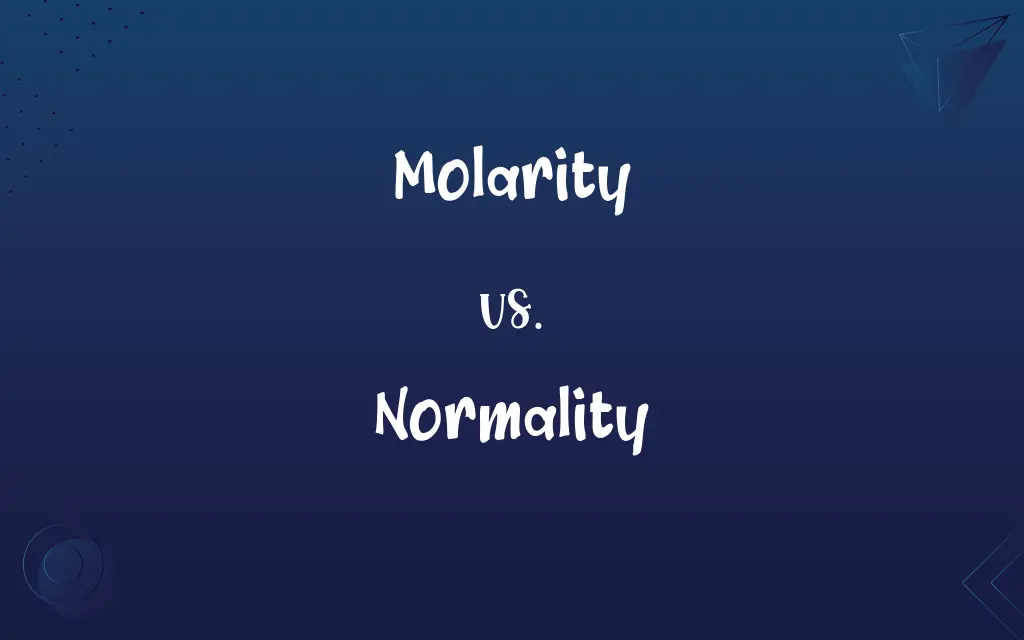Molarity vs. Normality: Know the Difference

By Shumaila Saeed || Published on January 4, 2024
Molarity measures the concentration of a solution in moles of solute per liter of solution, while normality measures the equivalent concentration based on reacting capacity.

Key Differences
Molarity, denoted as 'M,' is a unit of concentration that expresses the number of moles of a solute in one liter of solution. It is a fundamental measure in chemistry for quantifying how much of a substance is present in a given volume. Normality, on the other hand, is denoted as 'N' and measures the equivalent concentration of a solute in a solution. It accounts for the reactive capacity of the solute, focusing on its ability to donate or accept protons or electrons.
Shumaila Saeed
Jan 04, 2024
The concept of molarity is essential in stoichiometry as it directly relates to the number of particles in a solution. This makes it a straightforward measure for many chemical reactions and calculations. Normality extends the concept by considering the valence or reaction capacity of the solute, making it particularly useful in titration and redox reactions, where the reacting equivalents are crucial.
Shumaila Saeed
Jan 04, 2024
Calculating molarity involves dividing the number of moles of solute by the volume of the solution in liters. It simplifies the understanding of the concentration of compounds like salts, acids, and bases in a solution. Normality calculation, however, requires knowledge of the equivalent factor of the solute, which depends on the reaction in question. This factor adjusts the concentration to reflect the actual reacting proportion of the solute.
Shumaila Saeed
Jan 04, 2024
Molarity is universally applicable across all types of chemical solutions, providing a general understanding of concentration. It is not influenced by the type of chemical reaction the solute undergoes. In contrast, normality is specific to the type of chemical reaction, as different reactions may involve different numbers of ions or molecules reacting.
Shumaila Saeed
Jan 04, 2024
In summary, while molarity is a general measure of concentration based on the amount of solute, normality is a more specific measure that takes into account the chemical behavior of the solute. This makes normality especially useful in acid-base titrations and redox reactions, where the number of electrons or ions participating in the reaction is critical.
Shumaila Saeed
Jan 04, 2024
ADVERTISEMENT
Comparison Chart
Definition
Moles of solute per liter of solution
Equivalents of solute per liter of solution
Shumaila Saeed
Jan 04, 2024
Calculation
Moles of solute / Volume of solution in liters
Equivalents of solute / Volume of solution in liters
Shumaila Saeed
Jan 04, 2024
Application
General concentration measure in chemistry
Used in titrations and redox reactions
Shumaila Saeed
Jan 04, 2024
ADVERTISEMENT
Molarity and Normality Definitions
Molarity
Molarity quantifies the concentration of a substance in a solution.
A 2 M HCl solution is twice as concentrated as a 1 M HCl solution.
Shumaila Saeed
Dec 16, 2023
Normality
Normality is the number of equivalents of a reactive species per liter of solution.
A 1N H2SO4 solution can neutralize one equivalent of a base.
Shumaila Saeed
Dec 16, 2023
Molarity
Molarity is the number of moles of a solute per liter of solution.
A 1 M NaCl solution has 1 mole of sodium chloride in 1 liter of solution.
Shumaila Saeed
Dec 16, 2023
Normality
Normality measures the equivalent concentration of a solute in a solution.
In acid-base reactions, the normality of an acid solution determines its neutralizing capacity.
Shumaila Saeed
Dec 16, 2023
Molarity
Molarity measures the molecular concentration in a solution.
Increasing the molarity of a sugar solution makes it sweeter.
Shumaila Saeed
Dec 16, 2023
ADVERTISEMENT
Normality
Normality accounts for the reacting capacity of a solute.
The normality of an oxidizing agent indicates its ability to accept electrons.
Shumaila Saeed
Dec 16, 2023
Molarity
Molarity is used to express the strength of a chemical solution.
Laboratory acids are often stored in different molarities for various experiments.
Shumaila Saeed
Dec 16, 2023
Normality
Normality varies with the type of chemical reaction.
The normality of a solution in a redox reaction differs from its normality in an acid-base reaction.
Shumaila Saeed
Dec 16, 2023
Molarity
Molarity reflects the amount of a solute in a given volume of solvent.
A 0.5 M KCl solution contains half the amount of potassium chloride than a 1 M solution.
Shumaila Saeed
Dec 16, 2023
Molarity
Abbr. M The concentration of a solution expressed in moles of solute per liter of solution.
Shumaila Saeed
Dec 13, 2023
Normality
Abbr. N(Chemistry) The concentration of a solution expressed as the number of gram equivalent weights of solute per liter of solution.
Shumaila Saeed
Dec 13, 2023
Molarity
(chemistry) the concentration of a substance in solution, expressed as the number of moles of solute per litre of solution
Shumaila Saeed
Dec 13, 2023
Normality
(uncountable) The state of being normal or usual; normalcy.
Jessie was going to wear pants to school, but her brother persuaded her to wear shorts to preserve normality.
Shumaila Saeed
Dec 13, 2023
Molarity
Concentration measured by the number of moles of solute per liter of solvent
Shumaila Saeed
Dec 13, 2023
Normality
(chemistry) The concentration of a solution expressed in gram equivalent weights of solute per litre of solution.
Shumaila Saeed
Dec 13, 2023
Normality
A measure of how well an observed distribution approximates a normal distribution.
Shumaila Saeed
Dec 13, 2023
Normality
Conformity with the norm; the state of being normal; the normal condition.
Shumaila Saeed
Dec 13, 2023
Normality
(of a solution) concentration expressed in gram equivalents of solute per liter
Shumaila Saeed
Dec 13, 2023
Normality
Being within certain limits that define the range of normal functioning
Shumaila Saeed
Dec 13, 2023
Normality
Expectedness as a consequence of being usual or regular or common
Shumaila Saeed
Dec 13, 2023
Normality
Normality is used for solutions where the reaction equivalence is important.
Shumaila Saeed
Dec 16, 2023
Repeatedly Asked Queries
How is molarity calculated?
Molarity is calculated by dividing the number of moles of solute by the volume of the solution in liters (M = moles/volume in L).
Shumaila Saeed
Jan 04, 2024
What is the relationship between molarity and dilution?
Dilution involves adding solvent to decrease the molarity of a solution while keeping the total moles of solute constant.
Shumaila Saeed
Jan 04, 2024
What is a "molar solution"?
A molar solution has a concentration of 1 mole of solute per liter of solution (1 M).
Shumaila Saeed
Jan 04, 2024
How is normality different from molarity?
Normality accounts for the number of reactive species involved in a chemical reaction, whereas molarity considers only the moles of solute.
Shumaila Saeed
Jan 04, 2024
What is the difference between molarity and molality?
Molarity is a measure of concentration based on the volume of the solution, while molality is based on the mass of the solvent.
Shumaila Saeed
Jan 04, 2024
What is normality?
Normality (N) is a measure of the concentration of reactive species (ions or molecules capable of undergoing a specific reaction) in a solution.
Shumaila Saeed
Jan 04, 2024
What are "equivalents" in normality?
Equivalents are a measure of the amount of substance that can react with or replace one mole of hydrogen ions (H+) in an acid-base reaction.
Shumaila Saeed
Jan 04, 2024
What is molarity?
Molarity (M) is a measure of the concentration of a solute in a solution, expressed as the number of moles of solute per liter of solution.
Shumaila Saeed
Jan 04, 2024
What is the unit of molarity?
The unit of molarity is "moles per liter" (mol/L or M).
Shumaila Saeed
Jan 04, 2024
Why is molarity important in chemistry?
Molarity is crucial for precise and consistent measurements in chemical reactions, especially when preparing solutions with specific concentrations.
Shumaila Saeed
Jan 04, 2024
How is normality calculated?
Normality is calculated by multiplying the molarity by the number of equivalents per mole of the reactive species.
Shumaila Saeed
Jan 04, 2024
Can you convert normality to molarity and vice versa?
Yes, you can convert normality to molarity by considering the equivalents involved in the reaction and vice versa using the equation N = M × n, where n is the number of equivalents.
Shumaila Saeed
Jan 04, 2024
Can molarity be negative?
No, molarity cannot be negative since it represents a positive quantity related to the concentration of a solute.
Shumaila Saeed
Jan 04, 2024
Why is normality important in acid-base reactions?
Normality is used in acid-base titrations to determine the concentration of acidic or basic solutions accurately.
Shumaila Saeed
Jan 04, 2024
How is a stock solution related to molarity?
A stock solution is a highly concentrated solution used to prepare solutions of lower molarity through dilution.
Shumaila Saeed
Jan 04, 2024
What is the unit of normality?
The unit of normality is "equivalents per liter" (eq/L or N).
Shumaila Saeed
Jan 04, 2024
What is the difference between "equivalent weight" and "molar mass"?
Equivalent weight is the mass of a substance that can furnish one equivalent of the species in a reaction, while molar mass is the mass of one mole of the substance.
Shumaila Saeed
Jan 04, 2024
When is normality more appropriate than molarity in chemical calculations?
Normality is more suitable when dealing with reactions that involve multiple acidic or basic species or when considering substances that can donate or accept multiple equivalents in a reaction.
Shumaila Saeed
Jan 04, 2024
Can molarity be used for gases in the same way as for liquids?
Yes, molarity can be applied to gases, although the gas volume must be converted to liters under specific conditions.
Shumaila Saeed
Jan 04, 2024
Can normality be negative?
No, normality cannot be negative, as it represents a positive quantity related to the concentration of reactive species.
Shumaila Saeed
Jan 04, 2024
Share this page
Link for your blog / website
HTML
Link to share via messenger
About Author
Written by
Shumaila SaeedShumaila Saeed, an expert content creator with 6 years of experience, specializes in distilling complex topics into easily digestible comparisons, shining a light on the nuances that both inform and educate readers with clarity and accuracy.








































































